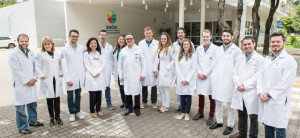Alzheimer´s Team
Lead researcher : Jaderson Costa da Costa, MD, PhD ; < / p>
Other members: Alexandre Rosa Franco, PhD ; Ana Maria Marques da Silva, PhD ; Celia Ribeiro da Silva Carlini, PhD ; Cristina M. Moriguchi Jeckel, PhD ; Cristina Sebastião Matushita, MD , MSc ; Daniel Marinowic, PhD ; Diogo Ribeiro Demartini, PhD ; Eduardo Zimmer, PhD ; Eliete Biasotto Hauser, PhD ; Evandro Manica, PhD ; Graciane Radaelli, MSc ; Leonardo Pisani ; Louise Mross Hartmann, MSc ; Lucas Schilling, MD, MSc ; Michele Alberton Andrade, MSc ; Mirna Wetters Portuguez, PhD ; Ricardo Bernardi Soder, MD, PhD ; Samuel Greggio, PhD ; Silas Reznicek ; Wyllians Vendramini Borelli ; and Zaquer Costa-Ferro, PhD .
Instigated by the mysteries and the growing importance of Alzheimer's Disease in Brazil and in the world, the Brain Institute has a group specialized in cerebral neurodegeneration: the Alzheimer’s Team. The group is led by Prof. Dr. Jaderson Costa da Costa, director of InsCer, and meets every 2 weeks with a focus on the study of Alzheimer's Disease through clinical and preclinical research projects. A major differential of the group is interdisciplinary teamwork, involving graduate students, physicists, chemists, pharmacists, biochemists, mathematicians, biologists, neuropsychologists and doctors. At the meetings, topics relevant to research into new biomarkers of the disease are addressed, through structural (magnetic resonance) and functional neuroimaging, in addition to the development of radiopharmaceuticals that assist in the diagnosis of this pathology, such as PET-CT associated with PIB-C 11 and FDG.
Understanding GDP-C 11
Nuclear medicine is a medical specialty that uses the injection of radioactive material into a patient's vein to study the functioning of a particular organ. This material is called a radionuclide. For this radionuclide to reach the target organ for study, it needs a drug that mimics a physiological substance in our organism and takes that radionuclide to the organ. The junction of this drug with the radionuclide is called a radiopharmaceutical. PIB-C 11 (Pittsburg Compound B, marked with carbon 11) is a radiopharmaceutical that marks beta-amyloid plaques that are concentrated in some parts of the brain (in the associative temporo-parietal region and posterior cingulate) ) in patients with Alzheimer's. The difficulty with radiopharmaceuticals that use carbon 11 is its duration, that is, the half-life. Thus, carbon 11 loses activity (decay) in 20 minutes. Therefore, there is a need for its production in the cyclotron to be very close to its application (use in the patient).
Important: what is known is that in patients who have MCI (Mild Cognitive Impairment, that is, minimal cognitive deficit) subtle cognitive changes occur , without significant impact on the performance of daily living activities and in the preclinical phase, it does not present any symptoms, but it is possible to document pathological changes through biomarkers that evidence the pathophysiological process of Alzheimer's disease and precede the first symptoms such as the accumulation of plaques beta-amyloids in the brain.
It is known that an important precursor in Alzheimer's disease is the deposition of a derivative of the beta-amyloid protein, which generates these plaques in the brain. Currently, the reference method that has to prove amyloid-cerebral deposition is the examination using Positron Emission Tomography (PET) in association with PIB-C radioactive drug 11 that binds specifically in the plates amyloid. What is intended at the Brain Institute of Rio Grande do Sul is to perform a morphological and functional MRI scan associated with the neurological PET-FDG and PET-PIB exam. Fluorine-labeled PET-FDG 18 allows the metabolism of different areas of the brain to be assessed and PET-PIB assesses the deposition of the beta-amyloid substance.
The decrease in FDG uptake in the mentioned areas (associative temporo-parietal region and posterior cingulate), through PET-FDG exams, for example, is already a standard of diagnosis established in Alzheimer's disease. With PIB, which is expected to be produced at InsCer's own Radiopharmaceutical Production Center, it is a specific marker of beta-amyloid plaques known to be retained in the concentration areas of such plaques in the brain, thus helping together with PET -FDG an Alzheimer's diagnosis.
UC-Irvine and InsCer-PUCRS
In 2015, InsCer promoted the School of High Studies, an event that, with the support of the Coordination for the Improvement of Higher Education Personnel (CAPES) and the Research Support Foundation in Rio Grande do Sul (FAPERGS) counted with the participation of renowned neuroscientist Howard Federoff, MD, PhD, from UC-Irvine (USA). With his team and with Michael Nalls, PhD, a scientist at the National Institutes of Health, Federoff addressed topics in neuroscience for students and professionals who work not only at the Institute but at other universities in the state. International researchers develop their research with biomarkers found in blood tests. The Irvine group (formerly Georgetown University) identified biomarkers (phospholipids) in the peripheral blood that predict the conversion of an individual with minimal cognitive impairment to Alzheimer's disease in 2-3 years.
This panel of biomarkers was expanded with greater accuracy in 2015. More recently, the group was able to identify in exosomes extracts (small vesicles inserted in the nerve terminal) derived from the brain but obtained in the peripheral blood of normal individuals and patients with Alzheimer's disease biomarkers that anticipate diagnosis of Alzheimer's disease by up to ten years . In yet another international cooperation agreement, the use of biomarkers from the UC-Irvine team and PET-PIB by InsCer-PUCRS takes Alzheimer's disease research to a new level of importance, as it allows the detection of asymptomatic stages of the disease (early diagnosis of Alzheimer's disease).
Photo: Bruno Todeschini / Photographic Archive / ASCOM / PUCRS



